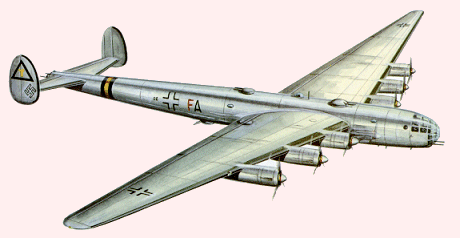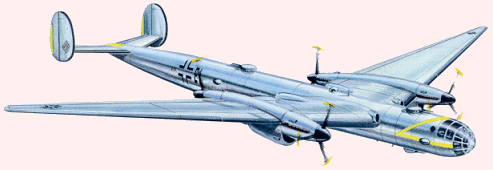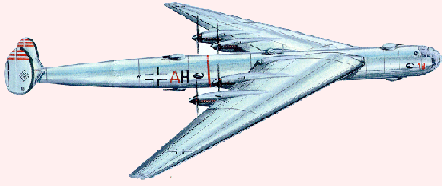 |
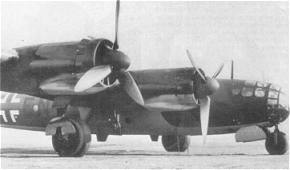 |
 |
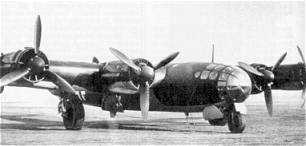 |
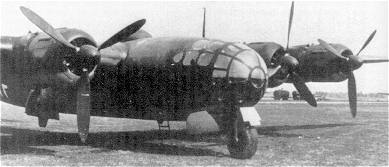 |
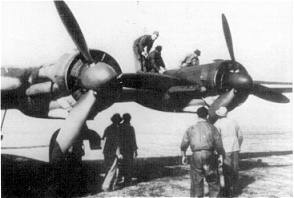 |
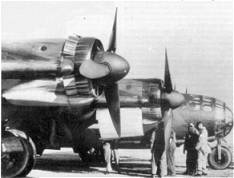 |
|
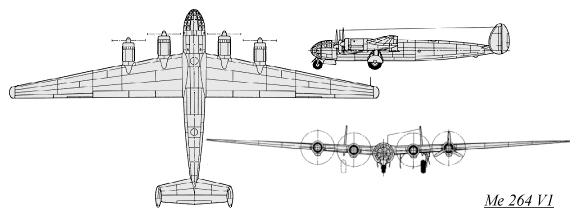 In 1937, the Messerschmitt development department started work on Projekt
1062 (which later became the Me 261), a long range aircraft used for
record distance attempts and eventually reconnaissance duties. Simultaneously,
another long range aircraft was in the development stage, Projekt 1061,
which was to be powered by four individual engines, and have a range of
20000 km (12428 miles). Due to more important projects in development at
the time (mainly the Bf 109 and 110), Projekt 1061 was only sporadically
worked on until late in 1940. The German Naval Warfare Department
wrote to Reichsmarschall Göring on August 10, 1940 that long range
aircraft with a range of at least 6000 km (3728 miles) would be needed
to reach the planned German Colonial Reich in central Africa. Also, about
this time the RLM issued a requirement for long range aircraft with a range
of at least 12000 km (7457 miles), to reach from French bases to the United
States, in anticipation of the coming war with the U.S. Therefore, the
work on Projekt 1061 was stepped up, with Willy Messerschmitt on
December 20, 1940 informing designers Wolfgang Degel, Paul Konrad and Waldemar
Voigt of the requirements for this long range aircraft. The initial requirements
were for a 20000 km (12428 miles) range, capability for military and civilian
roles, at least a 5000 kg (11023 lbs) bomb load to be carried in an internal
bomb bay, smaller bombs to be carried externally on under-wing pylons and
to have a very clean airframe. In early 1941, Messerschmitt received
an order to build six prototype Projekt 1061 aircraft, which were
given the designation of Me 264. If the aircraft proved capable,
a further 24 aircraft were to be built for "harassing attacks against
the United States".
In 1937, the Messerschmitt development department started work on Projekt
1062 (which later became the Me 261), a long range aircraft used for
record distance attempts and eventually reconnaissance duties. Simultaneously,
another long range aircraft was in the development stage, Projekt 1061,
which was to be powered by four individual engines, and have a range of
20000 km (12428 miles). Due to more important projects in development at
the time (mainly the Bf 109 and 110), Projekt 1061 was only sporadically
worked on until late in 1940. The German Naval Warfare Department
wrote to Reichsmarschall Göring on August 10, 1940 that long range
aircraft with a range of at least 6000 km (3728 miles) would be needed
to reach the planned German Colonial Reich in central Africa. Also, about
this time the RLM issued a requirement for long range aircraft with a range
of at least 12000 km (7457 miles), to reach from French bases to the United
States, in anticipation of the coming war with the U.S. Therefore, the
work on Projekt 1061 was stepped up, with Willy Messerschmitt on
December 20, 1940 informing designers Wolfgang Degel, Paul Konrad and Waldemar
Voigt of the requirements for this long range aircraft. The initial requirements
were for a 20000 km (12428 miles) range, capability for military and civilian
roles, at least a 5000 kg (11023 lbs) bomb load to be carried in an internal
bomb bay, smaller bombs to be carried externally on under-wing pylons and
to have a very clean airframe. In early 1941, Messerschmitt received
an order to build six prototype Projekt 1061 aircraft, which were
given the designation of Me 264. If the aircraft proved capable,
a further 24 aircraft were to be built for "harassing attacks against
the United States".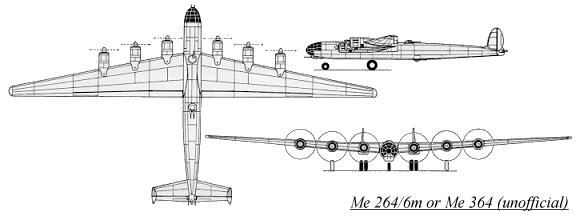 At the same time, Messerschmitt continued to work on a six engined version
of the Me 264, Projekt 1075. Since the Messerschmitt
design offices were running at full capacity, part of the design work was
delegated to the Fokker Works in Amsterdam.
At the same time, Messerschmitt continued to work on a six engined version
of the Me 264, Projekt 1075. Since the Messerschmitt
design offices were running at full capacity, part of the design work was
delegated to the Fokker Works in Amsterdam.
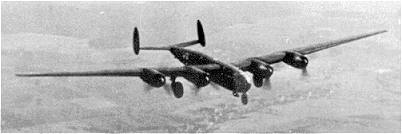 Meanwhile, the construction of the first prototype V1 was progressing very
slowly at Augsburg. At last, on December 23, 1942, the Me 264 V1 was ready
for its first test flight (please see the table
below for all test flight dates and results), which lasted 22 minutes.
The landing gear was left down due to safety concerns. The test flights
were later made at Lechfeld, because it had a sufficiently long concrete
runway to accommodate the large Me 264, but could test only the first prototype
due to the fact that the airfield facilities only had one hanger large
enough to house the Me 264 V1.
Meanwhile, the construction of the first prototype V1 was progressing very
slowly at Augsburg. At last, on December 23, 1942, the Me 264 V1 was ready
for its first test flight (please see the table
below for all test flight dates and results), which lasted 22 minutes.
The landing gear was left down due to safety concerns. The test flights
were later made at Lechfeld, because it had a sufficiently long concrete
runway to accommodate the large Me 264, but could test only the first prototype
due to the fact that the airfield facilities only had one hanger large
enough to house the Me 264 V1.
 The Me 264 V1 had a very "clean", all metal fuselage with a circular cross
section throughout. Just behind the extensively glazed nose and cockpit
was a galley, crew rest area and walkway to the rear of the plane above
the lower, enclosed bomb bay. The wings were shoulder mounted, slightly
swept back and tapered. They contained a single main spar and one auxiliary
spar, with the wing loads being transferred through the main spar and two
auxiliary bulkheads into the fuselage.
The Me 264 V1 had a very "clean", all metal fuselage with a circular cross
section throughout. Just behind the extensively glazed nose and cockpit
was a galley, crew rest area and walkway to the rear of the plane above
the lower, enclosed bomb bay. The wings were shoulder mounted, slightly
swept back and tapered. They contained a single main spar and one auxiliary
spar, with the wing loads being transferred through the main spar and two
auxiliary bulkheads into the fuselage. The entire fuel supply was stored in the large wings. All control surfaces
were conventional, including split flaps on the inner wing. The tailplane,
with its twin fins and rudders, was electrically adjustable during flight.
A tricycle landing gear system was designed, which was unusual for such
a large aircraft at this time. A single nose wheel was used, although testing
had been done for a twin nose wheel configuration using a converted Bf
109 (work number 5603). The test showed a loss of maneuverability, but
no shimmying. Because of the ever increasing weight demands, the main landing
gear was also to be strengthened, and even a droppable auxiliary main gear
was considered. The exterior of the Me 264 V1 was puttied and sanded all
over, to give the smoothest possible finish. The engines used on the first
prototype were the 12 cylinder, liquid cooled Junkers Jumo 211J-1 . These
were the same engines used on the Junkers Ju 88A-4
The entire fuel supply was stored in the large wings. All control surfaces
were conventional, including split flaps on the inner wing. The tailplane,
with its twin fins and rudders, was electrically adjustable during flight.
A tricycle landing gear system was designed, which was unusual for such
a large aircraft at this time. A single nose wheel was used, although testing
had been done for a twin nose wheel configuration using a converted Bf
109 (work number 5603). The test showed a loss of maneuverability, but
no shimmying. Because of the ever increasing weight demands, the main landing
gear was also to be strengthened, and even a droppable auxiliary main gear
was considered. The exterior of the Me 264 V1 was puttied and sanded all
over, to give the smoothest possible finish. The engines used on the first
prototype were the 12 cylinder, liquid cooled Junkers Jumo 211J-1 . These
were the same engines used on the Junkers Ju 88A-4 models, and to save time even the Ju 88 nacelles and radiators were utilized.
The Me 264 V2 was to have extended wing tips and 1000 kg (2200 lbs) of
armor added around the more vital parts of the aircraft. It was reportedly
being readied for preflight ground tests when it, too, was destroyed in
an air raid.
models, and to save time even the Ju 88 nacelles and radiators were utilized.
The Me 264 V2 was to have extended wing tips and 1000 kg (2200 lbs) of
armor added around the more vital parts of the aircraft. It was reportedly
being readied for preflight ground tests when it, too, was destroyed in
an air raid.
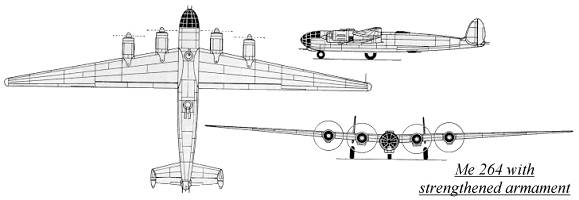 October
14, 1943 to discuss further development possibilities. According to Messerschmitt,
the components for the first five prototypes were completed, but he lacked
the necessary space and facilities in which to construct them. To get the
space for the Me 410 production, all the Me 264 final assembly building
jigs were moved from the Augsburg plant and stored at Gersthofen. Later
that day, GFM Milch wanted to stop the Me 264 completely, in order to concentrate
on the Me 262 jet fighter, to which Göering agreed. One day later,
the production orders for the Focke-Wulf Ta 400 was canceled, mainly because
the Focke-Wulf resources were needed for the Fw 190D-9 and Ta 152 production.
October
14, 1943 to discuss further development possibilities. According to Messerschmitt,
the components for the first five prototypes were completed, but he lacked
the necessary space and facilities in which to construct them. To get the
space for the Me 410 production, all the Me 264 final assembly building
jigs were moved from the Augsburg plant and stored at Gersthofen. Later
that day, GFM Milch wanted to stop the Me 264 completely, in order to concentrate
on the Me 262 jet fighter, to which Göering agreed. One day later,
the production orders for the Focke-Wulf Ta 400 was canceled, mainly because
the Focke-Wulf resources were needed for the Fw 190D-9 and Ta 152 production.
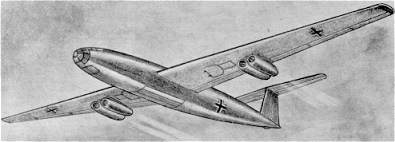 BMW
028 turboprop engined version and a twin BMW 018 turbojet powered version.
Another project was to have used Ritz heat exchangers to greatly increase
range. Perhaps the most unusual powerplant idea was for a steam turbine
that was to develop over 6000 horsepower and drive a 5.334 meter (17' 6")
diameter airscrew. Fuel would have been in a mixture of powdered coal and
petroleum. the main advantages to this engine would be constant power at
all altitudes and simple maintenance.
BMW
028 turboprop engined version and a twin BMW 018 turbojet powered version.
Another project was to have used Ritz heat exchangers to greatly increase
range. Perhaps the most unusual powerplant idea was for a steam turbine
that was to develop over 6000 horsepower and drive a 5.334 meter (17' 6")
diameter airscrew. Fuel would have been in a mixture of powdered coal and
petroleum. the main advantages to this engine would be constant power at
all altitudes and simple maintenance.
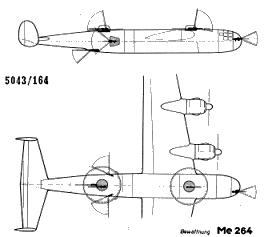 According to a study dated April 27, 1942, the long distance aircraft should
be able to fly reconnaissance missions as far as Baku, Grosnyj, Magnitogorsk,
Swerdlowsk, Tiffis or Tshejabinsk in the USSR, and flights to Dakar, Bathurst,
Lagos, Aden and southern Iran were also reachable. Not only were New Jersey
and New York in the U.S. within range, but also targets in Ohio, Pennsylvania
and even Indiana; in addition, there were plans to station some Me 264s
on Japanese bases on islands northeast of the Philippines, to fly reconnaissance
missions as far as Australia, India and much of the Pacific area. The updated
version of the Me 264 was to use the Jumo 222 engines with the GM-1 boost
system, which was under development at the time.
According to a study dated April 27, 1942, the long distance aircraft should
be able to fly reconnaissance missions as far as Baku, Grosnyj, Magnitogorsk,
Swerdlowsk, Tiffis or Tshejabinsk in the USSR, and flights to Dakar, Bathurst,
Lagos, Aden and southern Iran were also reachable. Not only were New Jersey
and New York in the U.S. within range, but also targets in Ohio, Pennsylvania
and even Indiana; in addition, there were plans to station some Me 264s
on Japanese bases on islands northeast of the Philippines, to fly reconnaissance
missions as far as Australia, India and much of the Pacific area. The updated
version of the Me 264 was to use the Jumo 222 engines with the GM-1 boost
system, which was under development at the time.
| Date | Test Pilot | Airfield | Results |
| December 23, 1942 | Karl Baur | Augsburg | After extensive taxiing trials, the Me 264 made its maiden flight. The duration of this first flight was 22 minutes, and for safety reasons the landing gear was left down. On landing, the airframe was damaged in the area of the flap mounts when the aircraft rolled over the end of the runway due to the failure of the brake system. |
| January 20, 1943 | Karl Baur | Augsburg | The second test flight was made. Karl Baur complained that the forces on the controls were too high, about the poor placement of the instruments and of exhaust fumes penetrating into the cockpit. |
| January 22, 1943 | Karl Baur | Augsburg | The Me 264 was transferred to Lechfeld. |
| January -
February, 1943 |
Karl Baur | Lechfeld | On the fifth test flight, the underside of the fuselage was damaged when it accidentally contacted the ground. Also, the hydraulic system of the landing gear failed, making it impossible to retract the gear. |
| February, 1943 | Karl Baur | Lechfeld | Baur reported some problems with the inner flaps and a defective nose wheel. Despite some changes to the control surfaces, the forces against them were still too high and the changes had displaced the center of gravity. The nose wheel problems were fixed, and now the retraction functioned properly. Also, some minor defects were found in the electrical cables of the intercom system. |
| February, 1943 | Gerhard Caroli | Lechfeld | Caroli also found that the forces against the control surfaces were still too high, especially at high speed. Small defects were still present in the radio system and landing gear. |
| February, 1943 | Karl Baur | Lechfeld | During two flights by Baur, a speed of 600 km/h (373 mph) was reached. The faulty trimming and controls revealed that an eventual change in the entire control system would be inevitably needed. Flights with two or three engines were found to be satisfactory, but in flights with the automatic controls it was found that the servos were too low powered to control such a heavy aircraft. |
| March 2, 1943 | Karl Baur | Lechfeld | Stability tests were continued. |
| March 4, 1943 | Karl Baur | Lechfeld | A test of the polare system was cut short when after 15 minutes of flying time, the third engine began to smoke and had to be cut out. At this time, 11 test flights had been made totaling 12 hours flight time. |
| March 23, 1943 | Karl Baur | Lechfeld | After the faulty engine was changed, the critical altitude tests were made. Several other test flights were made this day, mainly to check the longitudinal stability. Also, the first measures to improve the rudder effect was made. |
| March 23, 1943 | Karl Baur | Lechfeld | During landing, the left oleo leg broke, which was probably not fully locked down, causing some damage. |
| March 23 -
May 21, 1943 |
Lechfeld | During repairs, a new steering column, a reinforced wing skin, a modified nosewheel drive and a complete radio were added. Also, a new emergency tail skid was added, a changed tailplane and four new Jumo 211J engines were installed. | |
| May 22 -
June 5, 1943 |
Karl Baur | Lechfeld | Continued high forces against the ailerons and rudder surfaces were found. Six flights were made totaling 12 hour 16 minutes. |
| June 2, 1943 | Flight Capt. Wendel | Lechfeld | Serious problems arose when the nosewheel jammed during retraction. |
| June 10, 1943 | FBM Böttcher | Lechfeld | Reported that the cockpit excessively heated up in the summer sun. |
| August 11, 1943 | Lechfeld | The Me 264 V1 was taken out of service, and re-equipped with BMW 801 twin row radial engines. | |
| March 18, 1944 | Lechfeld | The Me 264 V1 was slightly damaged in an air raid, and was quickly repaired. | |
| April 14, 1944 | Lechfeld | During the first test roll with the new engines, the brake shoes tore off. | |
| April 16, 1944 | Lechfeld | The Me 264 V1 was transferred to Memmingen. | |
| April, 1944 | Memmingen | During the 38th test flight, the emergency skid was torn out after a rough landing. When the rudders were fitted with balances, the excessive vibrations almost ceased. | |
| late April, 1944 | FBM Scheibe | Lechfeld | Scheibe, from the Rechlin Trial Establishment, complained about the canopy reflections during his test flight. He also indicated that the excessive airframe vibrations were the number one problem to fix. |
| late April, 1944 | Colonel Barsewich | Memmingen | Barsewich, from the Chief Reconnaissance Department, judged the Me 264 V1 too slow for combat missions, even though the aircraft was about 10% faster than with the Jumo 211J engines. |
| early May, 1944 | Lt. Colonel Knemeyer | Memmingen | After an uneventful flight, Knemeyer was completely enthusiastic about the Me 264, in his opinion all problems could be overcome in the further testing and refinement of the aircraft. |
| April 17 -
May 17, 1944 |
Karl Baur | Memmingen | Flight testing was performed for tailplane flutter and the emergency tail skid. The rear of the plane was found to be too heavy. |
| April 26 -
May 3, 1944 |
Captain Nebel | Memmingen | Three test flights were made by Capt. Nebel of the Rechlin Test Establishment to finally redress the tail vibrations. To avoid building an entire new tail, balance weights were added to get the vibration problems under control. Since the problem was not solved, a larger tail plane seemed inevitable. |
| June 5, 1944 | Karl Baur | Memmingen | More stability tests were made, with a small improvement. However, the flights were complicated by the continuous problems with the Patin system. |
| June 6, 1944 | Karl Baur | Memmingen | Extreme rudder fluttering was found in the 380 - 450 km/h (236 - 280 mph) range. Also criticized were the too soft automatic controls, which had to be adjusted again. |
| June 26, 1944 | Karl Patin | Memmingen | A climb flight with combat performances was prematurely cut short when the fuel pressure of both inner engines fell to zero. After checking the fuel pumps, several defects were found. Also, the failure of the Patin, radio and electrical systems caused intensive repairs. |
| July 18, 1944 | Memmingen | The Me 264 (RE+EN, work number 264000001) was damaged during an air raid. The extent of the damages was too severe for the damage to be repaired. |
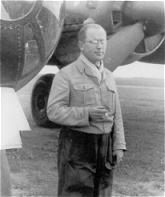 Test pilot Karl Baur (1913-1963), who flew every Messerschmitt development
aircraft.
Test pilot Karl Baur (1913-1963), who flew every Messerschmitt development
aircraft.
| Span | Length | Height | Wing Area | Fuselage Diameter |
| 43 m
141' 1" --------- (38.9 m) (127' 7") |
20.115 m
66' |
4.3 m
14' 1" |
127.7 m²
1374.56 ft² |
2.2 m
7' 3" |
| Empty
Equipped |
Crew (6) | Fuel | Oil | Nitrous
Oxide |
Normal
Loaded |
Max. Auxiliary
Fuel & Tanks |
Max.
Overload |
Jettisonable
Takeoff Equipment |
| 23360 kg
51500 lbs |
540 kg
1191 lbs |
19700 kg
43438 lbs |
1260 kg
2778 lbs |
680 kg
1500 lbs |
45540 kg
100416 lbs |
10500 kg
23152 lbs |
56040 kg
123568 lbs |
4300 kg
9481 lbs |
| Cruising
Speed |
Max.
Speed |
Service
Ceiling |
Max.
Range |
Max.
Endurance |
Climb Rate
(overload) |
Landing
Speed |
Takeoff Run
(Normal Load w/ RATO) |
| 350 km/h
218 mph |
545 km/h
339 mph |
8000 m
26240' |
15000 km
9315 miles |
45 hours | 120 m/min.
393 ft/min. |
160 km/h
99 mph |
1500 m
4920' |
| Manufacturer | Scale | Material | Notes |
| Airmodel #AM-022 | 1/72 | Vacuform | All vacuform kit. Contains parts for the V1-V3 versions.
Vacuform parts include: wheels, drop tanks, engines (both Jumo 211 and BMW 801), rudimentary cockpit parts and a wing spar. |
 |
 |
 |
 |
 |
 |
 |
|

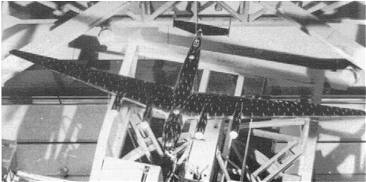 |
Windtunnel models of the planned production Me 264 |
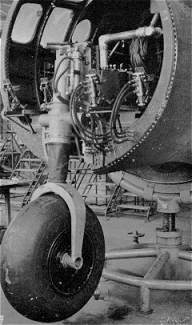 |
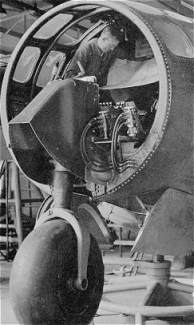 |
The nose wheel with and without its fairing. The
nosewheel retracted to the rear and rotated 90 degrees to lie flat beneath the cockpit. The size 935 x 345 nosewheel was not equipped with brakes. |
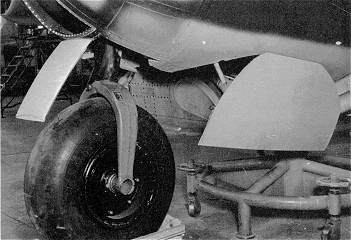 |
||
| Top right: A view into the main landing gear bay.
Bottom right: A view of the inner side of the landing
gear door.
Far right: The port main landing gear leg and wheel of the Me 264 V1. |
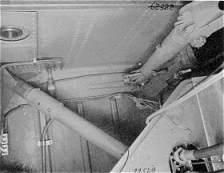
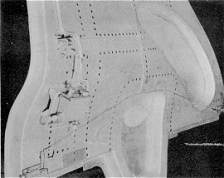 |
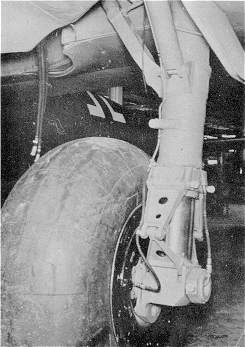 |
 |
 |
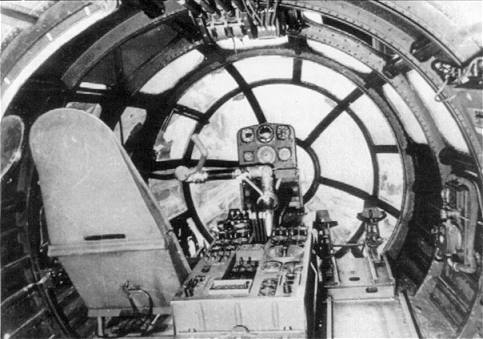
The Messerschmitt Me 264 V1 cockpit....
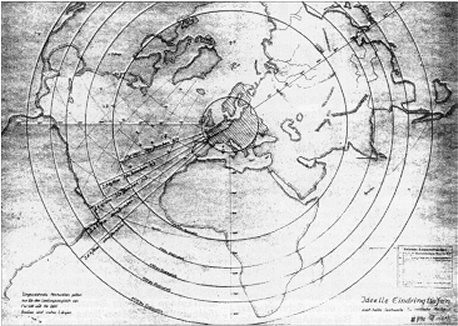
A penetration depth chart of the Me 264 from
May 12, 1944 Note: penetration depth equals half range....
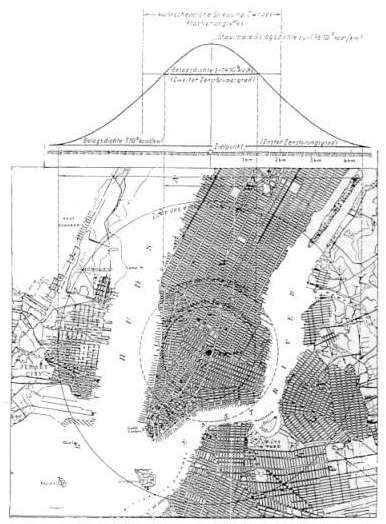
Target New York! Original document of 1943 showing
the differing range of degrees of destruction on Manhattan after an attack
by German long ranged bombers....

Me 264 with four BMW 028 Turboprops
